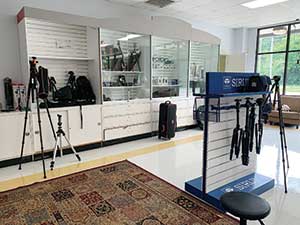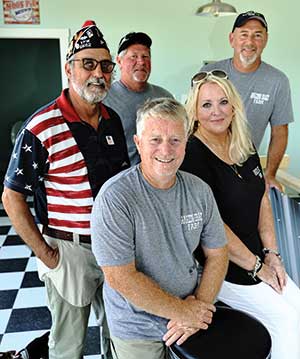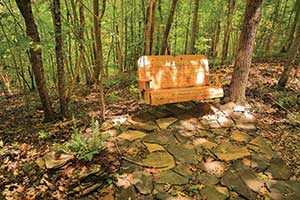Big milestones for region’s health care
Story by Katie Bohannon
Photos by Graham Hadley
Two pillars in Pell City’s health care community are celebrating a decade of service. In 2022, Ascension St. Vincent’s St. Clair hospital has begun its 11th year, and Col. Robert L. Howard Veterans Home commemorates 10 years of leading-quality practices and services for St. Clair County.
2805 John Haynes Drive witnessed the first workings of what would become Ascension St. Vincent’s St. Clair in Pell City, when a 68-bed licensed hospital opened in 1970. Ten years later, the hospital added a fourth floor, and the licensed beds rose to 82, before University of Alabama at Birmingham adopted management in 1985. Management shifted hands throughout the next decades, with Alabama Health Services, including Eastern Health System, St. Vincent’s and Brookwood, all playing a role until St. Vincent’s and Eastern Health System merged to form St. Vincent’s Health System in 2007.
In 2011, officials celebrated the 40-bed hospital’s opening at its current location – a tremendous venture illustrated by trusted community partnerships with Ascension Health, St. Vincent’s Health System, St. Clair County Commission, the city of Pell City, St. Clair County Healthcare Authority, and a collection of committed physicians and supportive citizens.
The hospital provides patients with numerous services, including Advanced Wound Care, Anesthesiology, Bariatric Surgery, Cardiology, Dermatology, Diabetes Education, Emergency Medicine, Family and Internal Medicine, Gastroenterology, General Surgery, Gynecology, Home Medical Equipment, Hyperbaric Medicine and Nephrology. It also offers practices in Neurology, Neurosurgery, Ophthalmology, Orthopedics, Otolaryngology, Pain Management, Pathology, Pediatrics, Physical Therapy, Radiology, Sleep Medicine, Speech Therapy, Urology and Inpatient Telemedicine for eICU, Stroke and Mental Health.
The hospital strives to maintain a positive presence in the community while collaborating with Community Health Clinic and Jefferson State Community College nursing program for clinicals. Its leadership team serves on multiple local boards throughout St. Clair County, reiterating Ascension’s mission as one of the leading nonprofit health systems in the United States. Based upon building a network of care patients trust, its staff dedicates itself to creating an environment where patients feel supported and receive personalized, convenient care.
“Care is about more than healing,” said Lisa Nichols, Ascension administrator. “We are here to serve, listen and understand, with support for physical health and wellness, as well as your mental and emotional health. At Ascension sites of care, care begins with addressing the whole person with dignity and respect. We begin every interaction by listening to understand you and your needs, respecting you, first as a person, then as a patient – because together, we are a community.”
State Veterans Home a beacon for health care
As St. Vincent’s St. Clair strives to care for patients, Col. Robert L. Howard State Veterans Home serves another deserving demographic.
The home celebrates its 10th anniversary in November this year, first opening its doors in 2012. Prior to construction, the Alabama Department of Veterans Affairs conducted a feasibility study to determine what area of Alabama most needed a State Veterans Home. Central Alabama proved to possess to the top need, and Pell City was selected as the best site for development.
Col. Robert L. Howard State Veterans Home provides residency for veterans who served a minimum of 90 days active-duty service, with one of those days during a war-time period. Residents have an honorable discharge, having lived in Alabama for 12 months before receiving eligibility to apply. Veterans pay a small fee to reside at the home, with state and federal departments of Veterans Affairs funding covering the majority of the living cost. Pell City’s location provides assisted living and domiciliary care, alongside skilled nursing services for residents as the home is licensed by the Alabama Department of Public Health and federal VA.
Pell City’s location generates a home-like environment for veterans, with fully furnished, modern rooms. Rooms are private with bathrooms in each unit, divided into smaller sections with living rooms, kitchens and dining rooms. The activities department ensures veterans remain engaged in a variety of opportunities throughout the year, including trips outside the facility to local restaurants and beloved locations a bit further away, such as Chattanooga, Tenn., and Columbus, Ga.
Col. Robert L. Howard Director Hiliary Hardwick has been with the home since its initial opening, witnessing every admission, every smile and every moment a veteran’s face lit up as he or she moved into their new home. She discussed the transition veterans experience after moving to the Pell City location, sharing the improvements that walk hand in hand with their new home.
“So many of our veterans’ quality of life has improved after moving in with us,” said Hardwick. “A lot are isolated at home because they may be wheelchair dependent and don’t have the resources to be able to go out of the house very often. Here, we have all necessary equipment and the transportation to get them out and about again. It also allows their loved ones to spend quality time with them,” she said.
“It’s important to help each veteran participate in the hobbies and activities they love. We have a large number who enjoy gardening, so we have raised planter beds to make access easier for those in wheelchairs. We have several veterans who love to paint, so we have art shows to showcase their work. Last year, we even installed a putting green for our veterans who enjoy golf.”
Hardwick emphasized the facility’s efforts to remain a good steward of its community. She illustrated her gratitude for the endless community support that flourished within the past decade, commending the numerous volunteers who assist with the home frequently.
Just this past year, LakeFest contributed a generous monetary donation to purchase gym equipment for the home’s DOM exercise room. In return, Col. Robert L. Howard reinvests in its community, serving as a clinical site for local schools for CNA, LPN and RN clinicals.
In fall 2022, the facility will serve as the host site for Project Search – a program that aids students with developmental disabilities in learning professional skills and finding employment after high school – with the Pell City School System and the St. Clair County School System.
Both St. Vincent’s St. Clair and Col. Robert L. Howard continuously maintain the relationships that perpetuate successful medical resources in the community. Nichols and Hardwick reflect on the changes both facilities have manifested in the past decade, while looking forward to another 10 years of changing the landscape of Pell City’s health care for the future.
“St. Vincent’s has improved access to care by expanding specialty coverage and TeleMed services,” said Nichols. “This allows our community to receive care locally without having to travel to other locations, like Birmingham. However, if your condition requires additional care, know that we are connected to a large network of providers, encompassing a wide range of specialties.”
Impacting the economy, as well as health care, “Col. Robert L. Howard State Veterans Home has brought more health care jobs to Pell City, as we employ over 300 employees,” said Hardwick. “Our opening along with the new hospital, have helped recruit and expand other health services here in Pell City. We also help support our local health care providers, as our veterans see many of the medical specialists in the community.”
Opening their doors within months of each other, their missions have continued a similar path over the past 10-plus years, delivering quality care close to home in service to their community. And the community, in return, continues to reap the benefits of those missions.

























